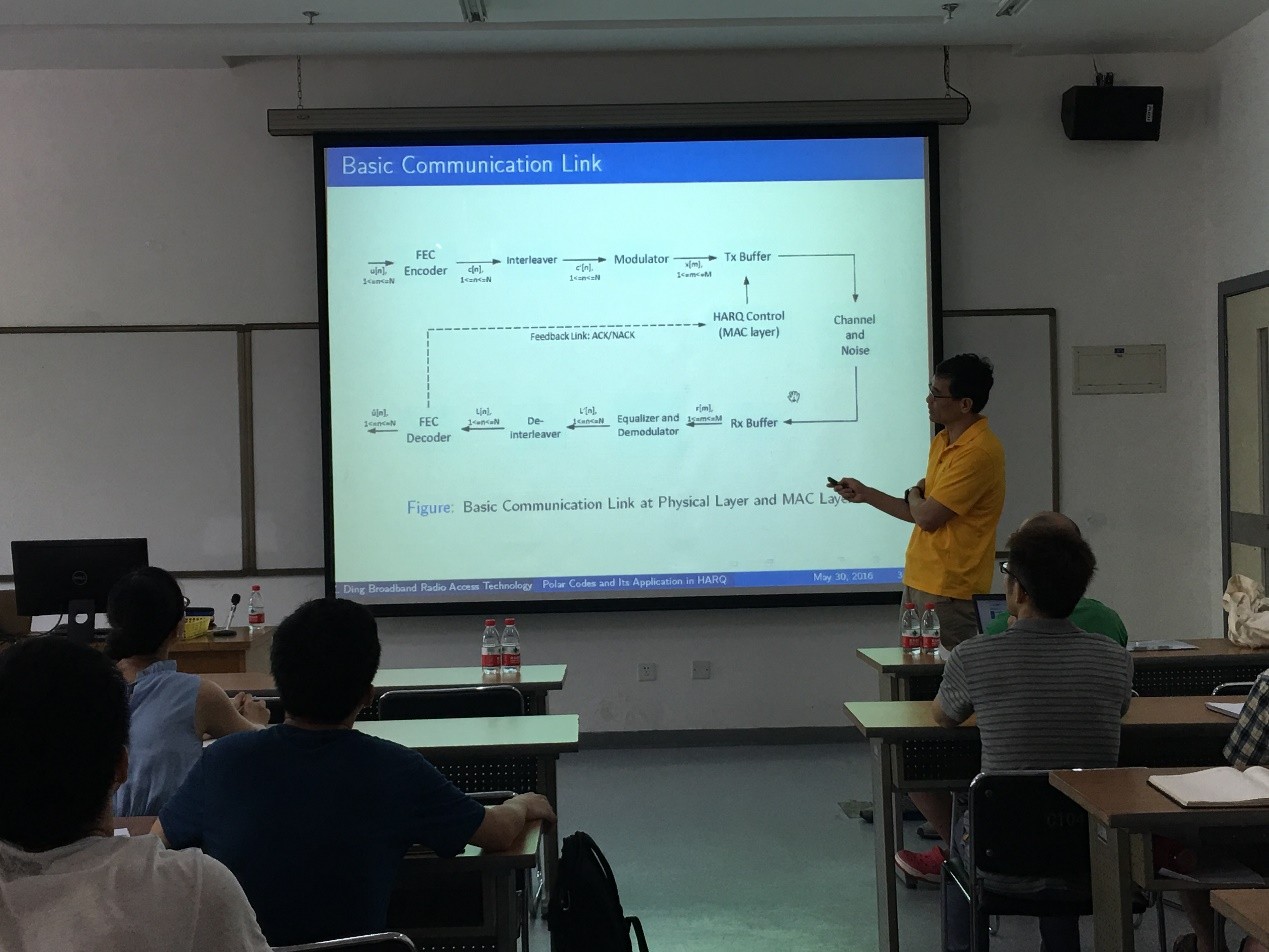2016年5月31日,美国加州大学戴维斯分校丁峙教授应我院李革教授邀请,在C-102教室做了一场题为“Polar Codes: Its Application in Retransmission for Wireless Communications and Joints Detection-Decoding Receivers”的精彩报告,介绍了极化码在无线通信中的作用及无线通信中最新的接收机结构设计。我院师生积极与其进行学术讨论与交流,大家受益匪浅。

丁峙教授首先通过流程图详细地介绍了无线通信的基本过程,说明了信道衰落的几种类型以及衰落引起的几种干扰,由此引出了对极化码这一改善传输性能信源编码技术的介绍。丁峙教授介绍了信道极化的原理,以两个符号的极化码为例阐述极化码的传输过程,并由两个符号的极化拓展到多个符号的极化,深入浅出地说明了极化码在无线通信中的作用。

然后,丁教授介绍了他所研究的Jscop-scc接收机的原理及结构,并与目前广泛使用的Turbo接收机进行对比分析。Jscop-scc这一接收机结合了均衡和调制的作用,具有创新意义;同时无论信道是在瑞利衰落还是莱斯衰落下,这一接收机性能都优于Turbo接收机,具有良好的研究价值。
交流提问环节,在场的师生都十分踊跃。李革教授和丁峙教授一起交流了Jscop-scc接收机的实际意义,该接收机将无线通信中的均衡模块和解码模块合二为一,大大提高了处理效率和准确度,也克服了以往两模块独立处理信号的问题。之后,樊宽刚博士结合矿井信号处理的研究经历就极化码的实际应用与丁教授进行深入地讨论。关于樊博士提出的“通过哪些措施可以降低矿井下无线传感器网络节点信号传输时多径衰落带来的影响”,丁教授提出了两个措施:第一,可以通过提高接收端硬件设备的精度,但需要花费一定的成本;第二,如果井下传感器节点固定,但经常有矿车经过,这可能对信号传输造成影响,此时极化码在一定程度上能提高通信质量。
报告人简介:
Zhi Ding (S'88-M'90-SM'95-F'03) is Professor of Electrical and Computer Engineering at the University of California, Davis. He received his Ph.D. degree in Electrical Engineering from Cornell University in 1990. From 1990 to 2000, he was a faculty member of Auburn University and later, University of Iowa. Prof. Ding has held visiting positions in Australian National University, Hong Kong University of Science and Technology, NASA Lewis Research Center and USAF Wright Laboratory. Prof. Ding has active collaboration with researchers from several countries including Australia, China, Japan, Canada, Taiwan, Korea, Singapore, and Hong Kong.
Dr. Ding is a Fellow of IEEE and has been an active member of IEEE, serving on technical programs of several workshops and conferences. He was associate editor for IEEE Transactions on Signal Processing from 1994-1997, 2001-2004, and associate editor of IEEE Signal Processing Letters 2002-2005. He was a member of technical committee on Statistical Signal and Array Processing and member of technical committee on Signal Processing for Communications (1994-2003). Dr. Ding was the General Chair of the 2016 IEEE International Conference on Acoustics, Speech, and Signal Processing and the Technical Program Chair of the 2006 IEEE Globecom. He was also an IEEE Distinguished Lecturer (Circuits and Systems Society, 2004-06, Communications Society, 2008-09). He served on as IEEE Transactions on Wireless Communications Steering Committee Member (2007-2009) and its Chair (2009-2010). Dr. Ding is a coauthor of the three texts: Modern Digital and Analog Communication Systems, 4th edition, Oxford University Press, 2009; Blind Equalization and Identification, Marcel Dekker, New York, 2001; Chapter 3: Global Convergence Issues With Linear Blind Adaptive Equalizer, in Blind Deconvolution, Simon Haykin, Ed., pp.60-120, Prentice-Hall, 1994. Furthermore, Dr. Ding is a single author of the three texts: Chapter 7: Linear Predictive Algorithms for Blind Multichannel Identification, in Signal Processing Advances in Wireless and Mobile Communications, Vol. I: Trends in Channel Estimation and Equalization, G. B. Giannakis, Y. Hua, P. Stoica, and L. Tong (Editors), Prentice Hall, 2000; Adaptive Filters for Blind Equalization, in IEEE DSP Handbook, Douglas B. Williams, Ed., pp.24.1-24.17, IEEE Press, 1998; Blind Channel Identification and Equalization using Spectral Correlation Measurements: Frequency Domain Analysis, in Cyclostationarity in Communications and Signal Processing, William A. Gardner, Ed., pp.417-436, IEEE Press, 1993.

丁峙教授首先通过流程图详细地介绍了无线通信的基本过程,说明了信道衰落的几种类型以及衰落引起的几种干扰,由此引出了对极化码这一改善传输性能信源编码技术的介绍。丁峙教授介绍了信道极化的原理,以两个符号的极化码为例阐述极化码的传输过程,并由两个符号的极化拓展到多个符号的极化,深入浅出地说明了极化码在无线通信中的作用。

然后,丁教授介绍了他所研究的Jscop-scc接收机的原理及结构,并与目前广泛使用的Turbo接收机进行对比分析。Jscop-scc这一接收机结合了均衡和调制的作用,具有创新意义;同时无论信道是在瑞利衰落还是莱斯衰落下,这一接收机性能都优于Turbo接收机,具有良好的研究价值。
交流提问环节,在场的师生都十分踊跃。李革教授和丁峙教授一起交流了Jscop-scc接收机的实际意义,该接收机将无线通信中的均衡模块和解码模块合二为一,大大提高了处理效率和准确度,也克服了以往两模块独立处理信号的问题。之后,樊宽刚博士结合矿井信号处理的研究经历就极化码的实际应用与丁教授进行深入地讨论。关于樊博士提出的“通过哪些措施可以降低矿井下无线传感器网络节点信号传输时多径衰落带来的影响”,丁教授提出了两个措施:第一,可以通过提高接收端硬件设备的精度,但需要花费一定的成本;第二,如果井下传感器节点固定,但经常有矿车经过,这可能对信号传输造成影响,此时极化码在一定程度上能提高通信质量。
报告人简介:
Zhi Ding (S'88-M'90-SM'95-F'03) is Professor of Electrical and Computer Engineering at the University of California, Davis. He received his Ph.D. degree in Electrical Engineering from Cornell University in 1990. From 1990 to 2000, he was a faculty member of Auburn University and later, University of Iowa. Prof. Ding has held visiting positions in Australian National University, Hong Kong University of Science and Technology, NASA Lewis Research Center and USAF Wright Laboratory. Prof. Ding has active collaboration with researchers from several countries including Australia, China, Japan, Canada, Taiwan, Korea, Singapore, and Hong Kong.
Dr. Ding is a Fellow of IEEE and has been an active member of IEEE, serving on technical programs of several workshops and conferences. He was associate editor for IEEE Transactions on Signal Processing from 1994-1997, 2001-2004, and associate editor of IEEE Signal Processing Letters 2002-2005. He was a member of technical committee on Statistical Signal and Array Processing and member of technical committee on Signal Processing for Communications (1994-2003). Dr. Ding was the General Chair of the 2016 IEEE International Conference on Acoustics, Speech, and Signal Processing and the Technical Program Chair of the 2006 IEEE Globecom. He was also an IEEE Distinguished Lecturer (Circuits and Systems Society, 2004-06, Communications Society, 2008-09). He served on as IEEE Transactions on Wireless Communications Steering Committee Member (2007-2009) and its Chair (2009-2010). Dr. Ding is a coauthor of the three texts: Modern Digital and Analog Communication Systems, 4th edition, Oxford University Press, 2009; Blind Equalization and Identification, Marcel Dekker, New York, 2001; Chapter 3: Global Convergence Issues With Linear Blind Adaptive Equalizer, in Blind Deconvolution, Simon Haykin, Ed., pp.60-120, Prentice-Hall, 1994. Furthermore, Dr. Ding is a single author of the three texts: Chapter 7: Linear Predictive Algorithms for Blind Multichannel Identification, in Signal Processing Advances in Wireless and Mobile Communications, Vol. I: Trends in Channel Estimation and Equalization, G. B. Giannakis, Y. Hua, P. Stoica, and L. Tong (Editors), Prentice Hall, 2000; Adaptive Filters for Blind Equalization, in IEEE DSP Handbook, Douglas B. Williams, Ed., pp.24.1-24.17, IEEE Press, 1998; Blind Channel Identification and Equalization using Spectral Correlation Measurements: Frequency Domain Analysis, in Cyclostationarity in Communications and Signal Processing, William A. Gardner, Ed., pp.417-436, IEEE Press, 1993.
 OA系统
OA系统
 学院邮箱
学院邮箱
 教务管理
教务管理
 资源下载
资源下载
 English
English





 发布时间:2016-06-07
发布时间:2016-06-07 浏览次数:
浏览次数: